Monterrey (Mexico, state of Nuevo León) 作者: 来源: 发布时间:2021-06-02
1. Population and Aea
Monterrey is the capital and largest city of the northeastern state of Nuevo León, Mexico. It is located in northeastern Mexico, at the foothills of the Sierra Madre Oriental.
Population: 1,109,171(2015)
Area: 324.8 km2 (125.4 sq mi)
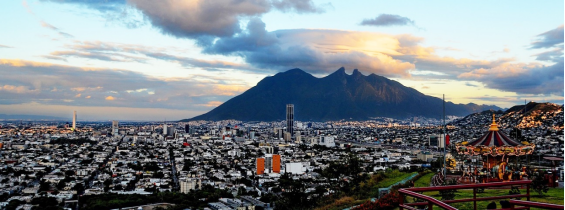
2. Geography
Monterrey big altitude view from Topo Chico
The city of Monterrey is 540 metres (1,770 ft) above sea level in the northeastern state of Nuevo León. Monterrey translated from Spanish to English is "King Mount" or "King mountain", which refers to the city's topography and the large mountains that surround it. The Santa Catarina River—dry most of the year on the surface but with flowing underground water—bisects Monterrey from east to west, separating the city into north and south halves, and drains the city to the San Juan River and Rio Grande.
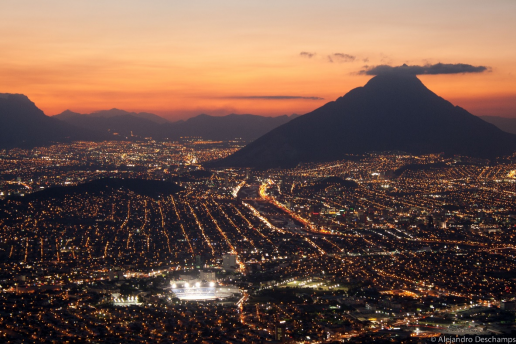
Monterrey lies north of the foothills of the Sierra Madre Oriental mountain range. A small hill, the Cerro del Topo, and the smaller Topo Chico are in the suburbs of San Nicolás de los Garza and Escobedo. West of the city rises the Cerro de las Mitras (Mountain of the Mitres), which resemble the profile of several bishops with their mitres.
Cerro de la Silla (Saddle Mountain) dominates the view at the east of the city and is considered a major symbol of the city. Cerro de la Loma Larga—South of the Santa Catarina river—separates Monterrey from the suburb of San Pedro Garza García. At the summit of the Cerro del Obispado, north of the river, is the historic Bishopric Palace, site of one of the most important battles of the Mexican–American War.
Natural areas
The mountains surrounding Monterrey contain many canyons, trails and roads that cross deserts and forests. Suitable trails are available to the general public. The Sierra Madre Oriental mountains south of the city are included in the "Parque Nacional Cumbres de Monterrey" (National Park), which was added to UNESCO’s Man and the Biosphere (MAB) Program of Biosphere Reserves in 2006.
Cumbres de Monterrey includes:
Parque Ecológico Chipinque, which contains forested areas (oak and oak-pine mainly).
La Estanzuela state park, about 7 km (4 mi) south of Monterrey, a river and forested area.
La Huasteca, west of the city, in the municipality of Santa Catarina.
El Potrero Chico Climbing Area, north east of the city, in the municipality of Hidalgo.
Garcia Caves – these caves are situated in Garcia, Nuevo Leon and were discovered in 1843. Inside you can see amazing stalagmites formations and snail fossils.
Matacanes – can be found in the municipality of Potrero Redondo in Santiago, Nuevo Leon. It is a 10 hrs walking tour in which you can find rappel descents, underground rivers, waterfalls, among other obstacles.
Hydrophobia Canyon – similar to Matacanes with the only difference this is a 100% aquatic area.
Cascade Cola de Caballo – a spectacular waterfall in Santiago Nuevo Leon, formed by water that runs down from the mountains of nearby Parque Nacional Cumbres de Monterrey, impressive rock formations and sprawling forests.
Cola de Caballo
(Waterfalls are common in the forested mountain terrain surrounding the city)
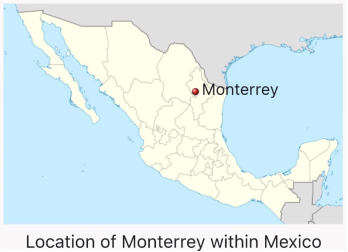
Transportation
Monterrey is connected with the United States–Mexico border, the sea and inland Mexico through different roads, including the Carretera Nacional (also known as the Panamerican Highway) that runs from Nuevo Laredo to Mexico City and south, and the Carretera Interoceánica connecting Matamoros with the port of Mazatlán on the Pacific; it is also crossed by highways 40, 45, 57. The divided highway Monterrey-Saltillo-Matehuala-Mexico City is the main land corridor to interior Mexico.
There are several between-cities bus lines at the bus station downtown. There are arrivals and departures into deeper Mexico, to the U.S. border and into the United States.
Monterrey is also connected by at least three important railroad freight lines: Nuevo Laredo-Mexico City, Monterrey-Tampico, and Monterrey-Pacific (Mazatlán).
The city has a rapid transit system called Metrorrey, which currently has 2 lines and a BRT called Ecovia.
The city is served by two international airports: General Mariano Escobedo International Airport (served by major international carriers and moving more than 6.5 million passengers in 2007) and Del Norte International Airport, a primarily private airport.
Monterrey is linked through frequent non-stop flights to many Mexican cities and to key United States hubs (Atlanta, Chicago-O'Hare, Dallas/Fort Worth, Detroit, Houston-Intercontinental, JFK/New York, and Las Vegas). Monterrey is the second most important city for the operating routes of Aeroméxico.
3. Economy
The city is the second most productive in Mexico with a GDP (PPP) of US$123 billion. And its purchasing power parity-adjusted GDP per capita is considerably higher than the rest of Mexico's at around US$35,500, compared to the country's US$18,800. It serves as a commercial center of northern Mexico and is the base of many significant international corporations.
The city has prominent positions in sectors such as steel, cement, glass, auto parts, and brewing. The city's economic wealth has been attributed in part to its proximity to the United States-Mexico border and economic links to the United States.
4. Industries and companies
Monterrey has global manufacturers from every major industry: aerospace & defense, electronics, medical devices, and automotive. One of its major subsectors is domestic electronics, such as washing machines and other household appliances, which account for 30% of Mexico’s national exports in this sector alone.
In addition to being home to thousands of foreign manufacturing companies, Monterrey is also home to some of Mexico’s largest brands: Pemex, Mexico’s oil company, and CEMEX, the world’s largest cement company.
CEMEX S.A.B. de C.V., known as Cemex, is a Mexican multinational building materials company headquartered in San Pedro, near Monterrey, Mexico. It manufactures and distributes cement, ready-mix concrete and aggregates in more than 50 countries. It is the second largest building materials company worldwide, only after LafargeHolcim. CEMEX currently operates on four continents, with 66 cement plants, 2,000 ready-mix-concrete facilities, 400 quarries, 260 distribution centers and 80 marine terminals. About one-third of the company's sales come from its Mexico operations, a quarter from its plants in the U.S., 15% from Spain, and smaller percentages from its plants around the world.
The city also produces most of Mexico’s steel. As of 2017, the manufacturing industry accounted for nearly a quarter of state GDP and over 60% of the Nuevo Leon’s exports.
Monterrey’s has 50 major industrial parks over five industrial areas ideal for manufacturing activities. At the end of the 3rd quarter of 2018, average lease cost hovered at $0.40-$0.43 per square foot, with 5.6 million SF available and 1.53 million under construction.
5. Tourist attractions
The Macroplaza
The Macroplaza, one of the world's largest squares, is the cultural and administrative heart of the city featuring remarkable monuments, green areas and buildings.

Barrio Antiguo
The "Callejón cultural" (Cultural Alleyway) at Mina Street in the Barrio Antiguo, which takes place every Sunday since 1992.
Barrio Antiguo (Old neighborhood or old town) is the historical urban center of the city of Monterrey. There are preserved the old houses from the 17th, 18th and 19th centuries. Nowadays bars, cafes, art galleries and restaurants can be found there. On November of every year the Festival Cultural Barrio Antiguo took place with national and international artists and performers, but now is replaced with the Festival Internacional de Santa Lucia, which now takes place in September.
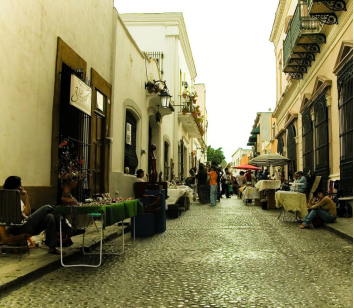
Fundidora Park
The Old Steel Mill at Fundidora Park
Fundidora Park is a large urban park that contains old foundry buildings, 120 hectares of natural ambiance, artificial lakes, playgrounds, alternative cinema (Cineteca), museum (Photo Collection, the State Plastic Arts Collection, Exhibits and Spaces), hotel, auditorium and convention center.
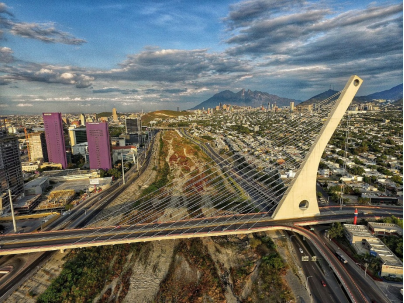
Puente de la Unidad
Puente de la Unidad (sometimes called Puente Atirantado) is a suspension bridge that crosses the Santa Catarina River and joins San Pedro Garza García with Monterrey.
6. History and culture
History
Prehispanic history
Before the European foundation of the city, there was no established nation-state, and the population consisted of some indigenous semi-nomadic groups. Carved stone and cave painting in surrounding mountains and caves have allowed historians to identify four major groups in present-day Monterrey: Azalapas, Huachichiles, Coahuiltecos and Borrados.
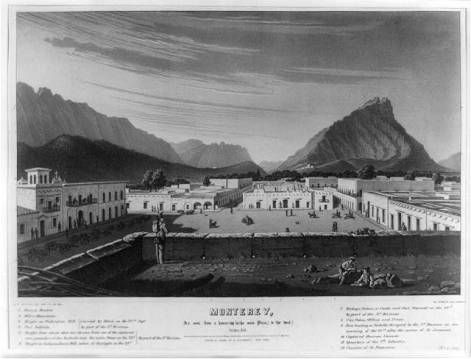
Foundation
In the 16th century, the valley in which Monterrey sits was known as the Extremadura Valley, an area largely unexplored by the Spanish colonizers. The first expeditions and colonization attempts were led by conquistador Alberto del Canto, who named the city Santa Lucia, but they were unsuccessful because the Spanish were attacked by the natives and fled. The Spanish expeditionary Luis Carvajal y de la Cueva negotiated with King Philip II of Spain to establish a territory in northern New Spain that would be called Nuevo León, the "New Kingdom of León". In 1580 he arrived in the newly granted lands but it was not until 1582 that he established a settlement called San Luis Rey de Francia (named for Saint Louis IX of France) within present-day Monterrey. The New Kingdom of León extended westward from the port of Tampico to the limits of Nueva Vizcaya ("New Biscay", now State of Chihuahua), and around 1,000 kilometers northward. For eight years Nuevo León was abandoned and uninhabited, until a third expedition of 13 families led by conquistador Diego de Montemayor founded Ciudad Metropolitana de Nuestra Señora de Monterrey ("Metropolitan City of Our Lady of Monterrey") on September 20, 1596, next to a water spring called Ojos de Agua de Santa Lucia, where the Museum of Mexican History and Santa Lucía riverwalk are now. The new city's name was chosen to honor the wife of Gaspar de Zúñiga, 5th Count of Monterrey, ninth Viceroy of New Spain.
Monterrey's Coat of Arms shows an Indian throwing an arrow to the sun in front of Cerro de la Silla mountain. This represents a native ceremony performed at sunrise.
During the years of Spanish rule, Monterrey remained a small city, and its population varied from a few hundred to only dozens. The city facilitated trade between San Antonio (now in Texas), Tampico and from Saltillo to the center of the country. Tampico's port brought many products from Europe, while Saltillo concentrated the Northern Territories' trade with the capital, Mexico City. San Antonio was the key trade point with the northern foreign colonies (British and French).
After Mexican Independence (19th century)
Monterrey in 1846
In the 19th century, after the Mexican Independence War, Monterrey rose as a key economic center for the newly formed nation, especially due to its balanced ties between Europe (with its connections to Tampico), the United States (with its connections to San Antonio), and the capital (through Saltillo). In 1824, the "New Kingdom of León" became the State of Nuevo León, and Monterrey was selected as its capital. But the political instability that followed the first 50 years of the new country allowed two American invasions and an internal secession war, during which the governor of the state annexed Coahuila and Tamaulipas states, designating Monterrey as the capital of the Republic of the Sierra Madre as it did before in 1840 for the Republic of the Rio Grande.
In 1846, the earliest large-scale engagement of the Mexican–American War took place in the city, known as the Battle of Monterrey. Mexican forces were forced to surrender but only after successfully repelling U.S. forces' first few advances on the city. The battle inflicted high casualties on both sides, much of them resulting from hand-to-hand combat within the walls of the city center.
Many of the generals in the Mexican War against France were natives of the city, including Mariano Escobedo, Juan Zuazua (b. Lampazos de Naranjo, NL) and Jerónimo Treviño.
Contemporary history
During the last decade of the 19th century, Monterrey was linked by railroad, which benefitted industry. It was during this period that José Eleuterio González founded the University Hospital, now one of northeast Mexico's best public hospitals, affiliated with the School of Medicine of the Autonomous University of Nuevo León (UANL). Antonio Basagoiti and other citizens founded the Fundidora de Fierro y Acero de Monterrey. The brewery Cervecería Cuauthemoc, one of the milestone local enterprises, was founded in 1890. A steel-producing company that accelerated the already fast industrialization of the city was founded in 1900 and became one of the world's biggest. In 1986, Monterrey hosted several games of the 1986 FIFA World Cup.
In 1988, Hurricane Gilbert caused great damage to the city; the Santa Catarina River overflowed, causing about 100 deaths and economic damage.
The city has hosted international events such as the 2002 United Nations Conference on Financing for Development with the participation of more than 50 heads of state and government, as well as other ministers and senior delegates from over 150 countries. The conference resulted in the adoption of the Monterrey Consensus, which has become a reference point for international development and cooperation. In 2004, the OAS Special Summit of the Americas was attended by almost all the presidents of the Americas.
In 2007, Monterrey held the Universal Forum of Cultures, with four million visitors. In 2008, Monterrey held the FINA World Junior Championships.
In 2010, Monterrey was hit by another damaging storm, Hurricane Alex. Alex was considered worse than Hurricane Gilbert, with record-breaking rain bringing floods and causing severe economic damage. Damage estimates totaled US$1.885 billion and $16.9 billion MXN. Reconstruction and urban renewal ensued. Recently, the Nuevo León Development Plan 2030 was presented, along with some other metropolitan projects.
In August 2011 the city was the scene of a terror attack on a casino, in which more than 50 people were killed.
Culture
Cuisine:Cabrito (kid goat), Monterrey's most popular traditional dish
The most traditional dish from Monterrey is cabrito, kid goat cooked on embers. Other local dishes and customs that perhaps date back to the Crypto-Judaism of Monterrey's founding families are the "semita" (bread without leavening), the capirotada dessert (a mix of cooked bread, cheese, raisins, peanuts, and crystallized sugarcane juice), and the relative absence of pork dishes. Another famous local dish is machacado con huevo.
Carne asada on weekends remains a tradition among Monterrey families. It is usually served with grilled onions, baked potatoes and sausages or chopped as tacos. Locally brewed beer and cola are an almost mandatory part of the weekly ritual. "Glorias" and "obleas," made from goat milk, are both traditional Nuevo León desserts.
Sports
Soccer is very popular in Mexico and Monterrey is no exception to that rule. The city is home to two teams, Los Tigres which are the team of the local university, Universidad Autónoma de Nuevo León, and Los Rayados, members of the Mexican League. Los Tigres play at the Estadio Universitario which in located in a downtown section of the city. This stadium has hosted professional cup games and has a capacity of about 50,000 people.
Los Rayados play at Estadio Tecnológico, also in Monterrey, which was host to the 1986 Soccer FIFA World Cup and holds 38,000 people.
Baseball is also an important sport in Mexico. Many of the Major League players in the US come from the country. Monterrey's team, the Sultanes , play in the Mexican League and draw large crowds. The team tried to purchase the failing Major League franchise, the Montreal Expos, in 2003, but was not successful.
Contemporary music
Since the 1960s, Monterrey has been known for "Norteño" music. Bands like Ramon Ayala, Pesado, Duelo and other Mexican "regional" bands perform at the clubs. Monterrey has witnessed the birth of several bands that have become internationally acclaimed. Their genres vary considerably. Bands include Plastilina Mosh, Control Machete, Kinky, El Gran Silencio, Celso Pina, Jumbo, Division Minuscula, Genitallica, 3Ball MTY, The Warning, GAMA, Los Claxons. The song "Los Oxidados" by Plastilina Mosh opened the 2005 movie Mr. & Mrs. Smith.
7. Other information
It is considered a Beta World City, cosmopolitan and competitive.
It is also considered to be the most “Americanized” city in the country.
Monterrey was ranked 94th worldwide and fifth in Latin America in terms of Quality of Life according to Mercer Human Resource Consulting (2006), and was ranked second in 2005 and fourth in 2006, according to América Economía.
8. Contact
Mayor: Adrián de la Garza
Website: http://www.monterrey.gob.mx/
Facebook: @mtygob
Tel: +52 81 8130-6565
Office address: Palacio Municipal de Monterrey, Zaragoza y Ocampo S/N, Zona Centro Monterrey, N.L., Mexico
